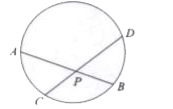Two circles touch each other externally at P. Two secants APB and CPD are drawn through P to meet the circle at A, C and B, D respectively. Then, which one of the following is correct ?
AC is perpendicular to BD
AC intersects BD
AC is parallel to BD
None of the above
To solve the problem, we need to analyze the given situation involving two circles that touch each other externally at point P, and two secants APB and CPD drawn through P.
1. Understanding the Configuration:
- We have two circles that touch each other externally at point P.
- Two secants APB and CPD are drawn through point P, intersecting the circles at points A, B and C, D respectively.
Hint: Visualize the two circles and the secants to understand their relationships.
2. Identifying Angles:
- Let’s denote the angles formed by the secants at point P.
- The angle ∠APB is formed by secant APB and the angle ∠CPD is formed by secant CPD.
Hint: Remember that angles formed by two intersecting lines can provide important relationships.
3. Using the Property of Tangents:
- Since the circles touch each other externally at point P, the angles formed by the secants at point P will have specific relationships.
- Specifically, the angle ∠APN (where N is the point of tangency on the larger circle) will be equal to the angle ∠CPM (where M is the point of tangency on the smaller circle).
Hint: Recall the property that angles formed by a tangent and a chord through the point of contact are equal to the angles in the alternate segment.
4. Establishing Angle Relationships:
- From the above, we conclude that ∠APN = ∠CPM.
- Similarly, we can establish that ∠BPM (for the larger circle) is equal to ∠DPN (for the smaller circle).
- Thus, we have:
- ∠APN = ∠CPM
- ∠BPM = ∠DPN
Hint: Use the properties of angles in triangles and circles to establish equalities.
5. Applying the Triangle Angle Sum Property:
- In triangles ACP and BDP, we can see that:
- ∠APN = ∠BPM and ∠CPM = ∠DPN.
- Therefore, if two angles of triangle ACP are equal to two angles of triangle BDP, the triangles are similar.
Hint: Remember that if two angles of one triangle are equal to two angles of another triangle, the triangles are similar.
6. Concluding Parallel Lines:
- Since the corresponding angles of the triangles ACP and BDP are equal, we can conclude that the lines AC and BD are parallel (by the converse of the alternate angle theorem).
- Therefore, we have AC || BD.
Hint: Use the concept of alternate angles to conclude the parallelism of the lines.
Final Answer:
The correct option is that AC is parallel to BD.
- We have two circles that touch each other externally at point P.
- Two secants APB and CPD are drawn through point P, intersecting the circles at points A, B and C, D respectively.
- Let’s denote the angles formed by the secants at point P.
- The angle ∠APB is formed by secant APB and the angle ∠CPD is formed by secant CPD.
- Since the circles touch each other externally at point P, the angles formed by the secants at point P will have specific relationships.
- Specifically, the angle ∠APN (where N is the point of tangency on the larger circle) will be equal to the angle ∠CPM (where M is the point of tangency on the smaller circle).
- From the above, we conclude that ∠APN = ∠CPM.
- Similarly, we can establish that ∠BPM (for the larger circle) is equal to ∠DPN (for the smaller circle).
- Thus, we have:
- ∠APN = ∠CPM
- ∠BPM = ∠DPN
- In triangles ACP and BDP, we can see that:
- ∠APN = ∠BPM and ∠CPM = ∠DPN.
- Therefore, if two angles of triangle ACP are equal to two angles of triangle BDP, the triangles are similar.
- Since the corresponding angles of the triangles ACP and BDP are equal, we can conclude that the lines AC and BD are parallel (by the converse of the alternate angle theorem).
- Therefore, we have AC || BD.
The correct option is that AC is parallel to BD.
Similar Questions
Knowledge Check
The two circles touch each other if
Ac=√a2+b2B1c=1a2+1b2Cc=1a2+1b2Dc=1a2+b2Two circles touch each other externally at point A and PQ is a direct tangent which touch circle at P and Q respectively then ∠PAQ = ?
A45∘B90∘C80∘D100∘Two circles touch each other externally at a point P and a direct common tangent touches the circles at the points Q and R respectively. Then ∠QPR is
A45∘B180∘C90∘D60∘
If two circles S=0 and s'=0 are touch each other externally then
View SolutionTwo circles with radius 4 cm and 9 cm respectively touch each other externally. Their common tangent touches the circles at point P and Point Q respectively. Then, area of the square with side PQ is.
View SolutionC1andC2 are two circle which touch internally at point P. Two lines PCA and PDB meet circle C1 at C and D and circle C2 at A and B respectively. If ∠BDC=120∘ then what is value of ∠ABP. (If CD||AB)
View SolutionTwo circles with radii 5 cm and 8 cm touch each other externally at a point A. If a straight line through the point A cuts the circles at points P and Q respectively, then AP : AQ is
View SolutionTwo chords AB and CD of a circle intersects each other at P. which of the following is correct?

View Solution
